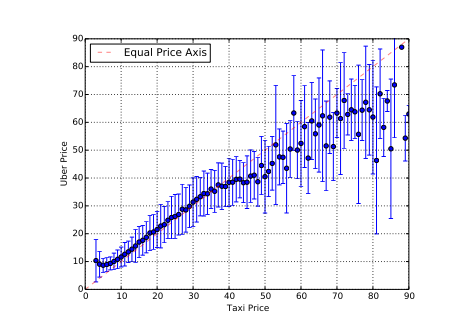Data Mining Reveals When a Yellow Taxi Is Cheaper Than Uber
The crowdsourced cab service, Uber, is currently taking the world by storm. Commuters use the service’s smartphone app to order a car, a request that is forwarded to the nearest available driver who then makes the pick-up.

Uber itself determines the cost of the fare so no money changes hands in the cars. Uber determines its fares by the service it offers, by the time a journey takes and sometimes by the distance traveled. The price also increases when demand is higher. On New Year’s Eve in 2011, for example, fares were reportedly seven times the normal rates.
It’s fair to say that Uber has alienated the official taxi drivers in many cities around the world. The company has come up against numerous backlashes and regulatory issues. But it is nevertheless wildly popular.
So here’s an interesting question: is Uber cheaper than conventional taxis? Today, we get an answer thanks to the work of Cecilia Mascolo at the University of Cambridge in the U.K. and a few pals who have compared Uber’s prices with those of Yellow Taxis in New York City. They say the ability to compare prices in this way should help commuters choose the cheapest options and thereby help control costs for all cab users.
The team’s method is possible because of a 2014 freedom of information request for the data associated with New York City Yellow Taxi journeys during the whole of 2013.
This data set is vast, covering hundreds of millions of trips and tipping the scales at 50 gigabytes. It consists of the location of every pick up and drop off as well as the fare paid for each journey.
Comparing it with Uber’s price at any instant is straightforward. Mascolo and co took the coӧrdinates of each journey made in a Yellow Taxi in 2013 and then asked Uber how much it would charge for the same journey using the cheapest version of the service, called Uber X.
Uber then suggested a minimum and maximum possible fare, which Mascolo and co used to take an average. They then compared this figure against the Yellow Taxi fare.
The results make for interesting reading. “Uber appears more expensive for prices below 35 dollars and begins to become cheaper only after that threshold,” say Mascolo and co.
That’s interesting because human mobility is characterized by vast numbers of short trips and relatively small numbers of long trips. “This observation therefore suggests that Uber’s economical model exploits this trend of human mobility in order to maximize revenue,” say Mascolo and co.
There are two important caveats to this work. First, the Yellow Taxi data comes from 2013 while the Uber data comes from 2014. However, Yellow Taxi prices are set by the city and last changed in 2012 after being held constant for eight years. So the 2013 fares should be a good indicator of 2014 fares as well.
Second, Uber X prices vary according to demand and Mascolo and co took no account of this in their comparisons. They argue that the comparison is interesting and useful nonetheless. “We argue that the process of comparing two different companies that provide the same service in the same geographic area is of value to commuters,” they say.
What’s interesting about this work is that it opens up the possibility of real transparency for commuters in choosing the most cost effective service. “Our observations show that it might be financially advantageous on average for travelers to choose either Yellow Cabs or Uber depending on the duration of their journey,” say Mascolo and co.
To help commuters, these guys have developed an app called OpenStreetCab that allows people to compare Uber prices with the equivalent journey in a Yellow Taxi. Of course, this service only works in New York, at least until the team can get their hands on comparable datasets for other cities.
Whether that will be possible isn’t clear. But it is a step toward airline type price comparisons for people who want to use cabs and that should surely benefit consumers in the long term.
Ref: arxiv.org/abs/1503.03021 : OpenStreetCab: Exploiting Taxi Mobility Patterns in New York City to Reduce Commuter Costs
Keep Reading
Most Popular
Large language models can do jaw-dropping things. But nobody knows exactly why.
And that's a problem. Figuring it out is one of the biggest scientific puzzles of our time and a crucial step towards controlling more powerful future models.
The problem with plug-in hybrids? Their drivers.
Plug-in hybrids are often sold as a transition to EVs, but new data from Europe shows we’re still underestimating the emissions they produce.
Google DeepMind’s new generative model makes Super Mario–like games from scratch
Genie learns how to control games by watching hours and hours of video. It could help train next-gen robots too.
How scientists traced a mysterious covid case back to six toilets
When wastewater surveillance turns into a hunt for a single infected individual, the ethics get tricky.
Stay connected
Get the latest updates from
MIT Technology Review
Discover special offers, top stories, upcoming events, and more.